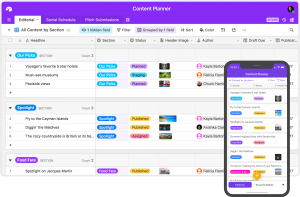AWS Startups Blog
Airtable CEO Howie Liu on Customers, Excess, and ‘Neural Nets’ for Advice

While entrepreneurs, financiers, and reporters tend to flock to “hot” sectors, like AI, autonomous driving, or cryptocurrency, the truth is, companies built around “boring” topics, like human resources or small business loans, are often the ones still standing in the long run.
Just ask Airtable CEO Howie Liu. After selling his first startup, the CRM company Etacts, to Salesforce when he was 21, Liu could have focused his efforts on any number of subjects. Instead, he decided start Airtable, a collaboration platform that essentially modernizes one of the least sexy products around: spreadsheets.
Liu says that while at Salesforce, where he worked for a year following the sale of his startup, he realized he was more interested in developing toolkits, as opposed to the tools themselves. He also wanted to stick to the world of software platforms, and spreadsheets seemed a natural place to start.
After raising $3 million from a consortium of financiers including Freestyle Capital, the Box Group, and actor Ashton Kutcher (who also invested in Etacts), Liu and his team spent most of 2012 conducting user research and working on a prototype of what would become Airtable. They launched in 2015 and later raised a subsequent round of Series A financing.
We spoke to Liu about how he’s embraced unintended customers, lessons he’s learned as a two-time founder, and Airtable’s plans for 2018.
AWS Startup Stories: Your product is used by a lot of media companies like Buzzfeed, Group Nine Media, and Condé Nast Entertainment. Given that media is a sector not commonly served by startups, how did breakthrough?
Howie Liu: Media companies like the ones you mention often use Airtable for content production and editorial calendaring, and to be honest, the use case fell into our laps. When we started, we didn’t have many templates for this vertical—and it was more by accident that many media companies discovered our product early on, loved the interface, and then built their entire digital plan into the platform. Other media customers found us through word of mouth. After that particular use case took off, we started building out other templates and offering them on our site.

Howie Liu, CEO of Airtable
As a two-time founder, what do you wish you knew back when you started that you know now?
In my early startup days, I didn’t fully appreciate the importance of compounding effects. Success begets success. If you build a product, then you can launch it, which allows you can hire more people, which allows you to build more products. It’s a virtuous cycle. It’s not even that important what your linear progression rate is. So if you can push even a little bit harder when it comes to product, you should do it—but not in a sloppy way. It’s not useful to launch a crappy MVP. All products should be launched in a balanced and deliberate way.
As a younger founder, I’m sure you’re inundated with advice. How do you choose who to listen to?
If you listen to every piece of advice, you’d be running in zigs and zags. My cynical view is that advice very cheap and one of the best skills an entrepreneur can build is creating a “neural net” for advice—that is, learning how to process the right advice and when to apply each piece of wisdom.
That said, what advice would you give other founders?
I strongly believe in creativity and keeping costs low. What that means, is that I think you can do just as much with a very small, but very aligned small team as you can get with a big team. As with all software startups, our headcount is a big cost so when we started, we tried to do more with less. We’re not curmudgeonly, but we do try to eschew Silicon Valley excess. For example, instead of excessive parties, we’ll do cakes and cupcakes to celebrate big milestones.
Who were Airtable’s first customers?
When the product was free, there were a lot of early adopters. After we turned on paid plans, I don’t remember the very first customer, but certainly, the media companies were amongst the earliest. One media company started paying us over $10,000 per year on a credit card—no questions asked—and we had a moment where we realized, ‘Wow, a company is paying us real money for what we built.’ Now, we have everyone from SMBs and Fortune 500 companies using our products, from sectors that range from media to retail to marketing.
What are your plans for 2018?
We’re looking to significantly expand our team in 2018. We have some major product improvements around fulfilling enterprise needs and will be introducing features like more granular permissioning. In general, we’re looking to scale while making sure everything is operating in a smooth way.